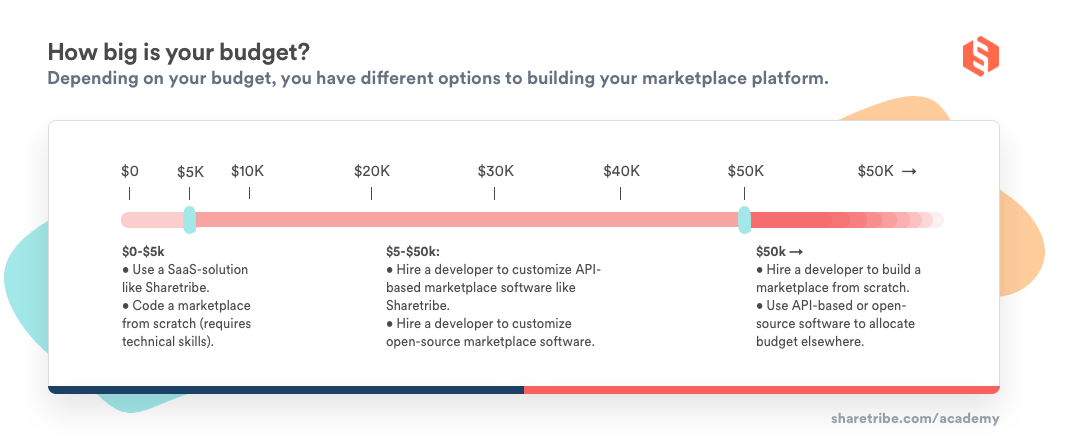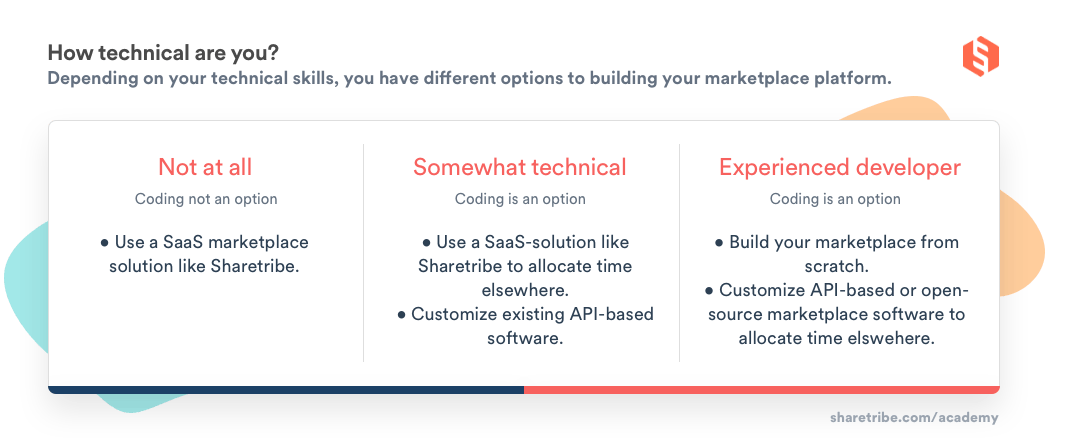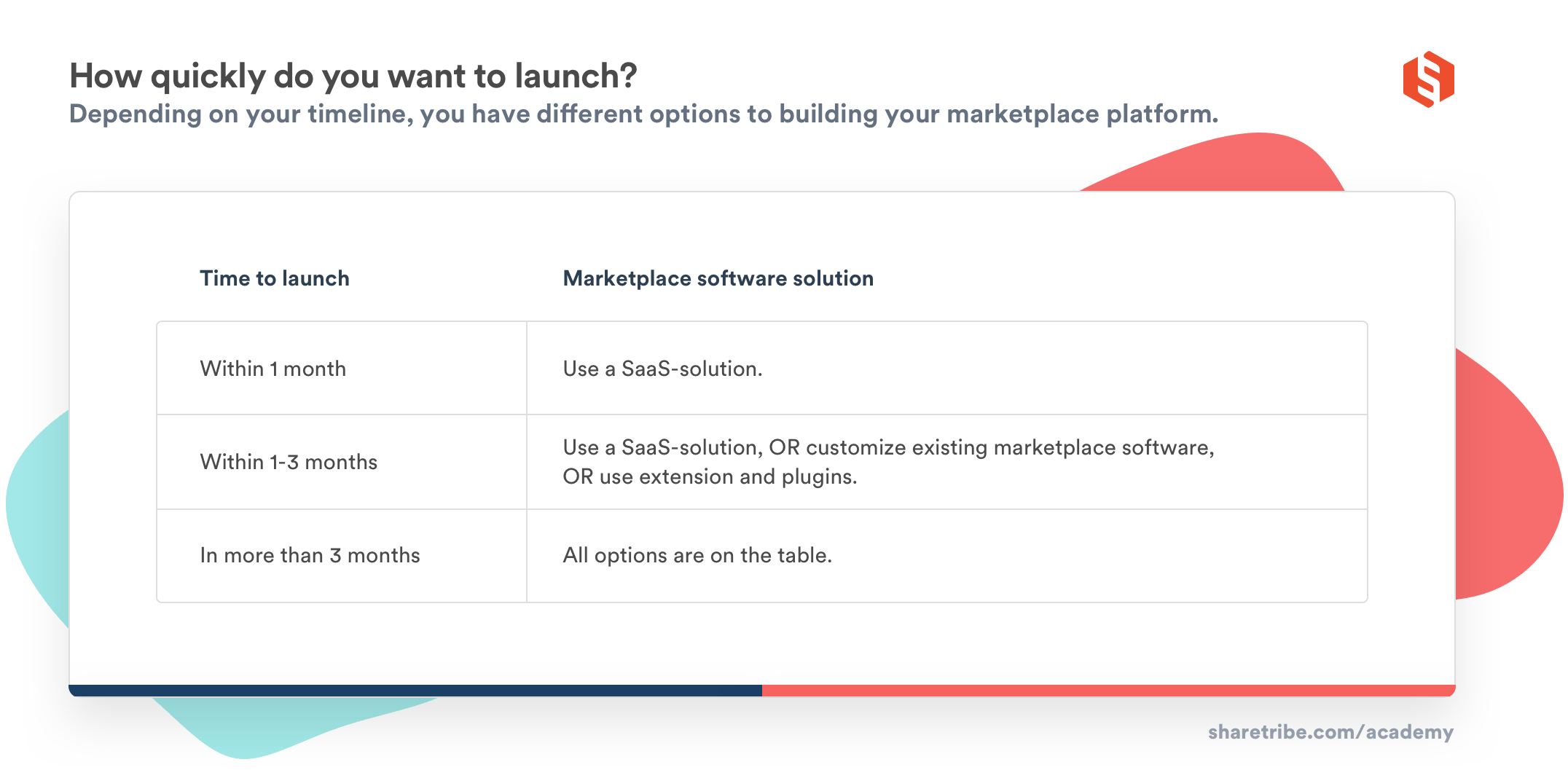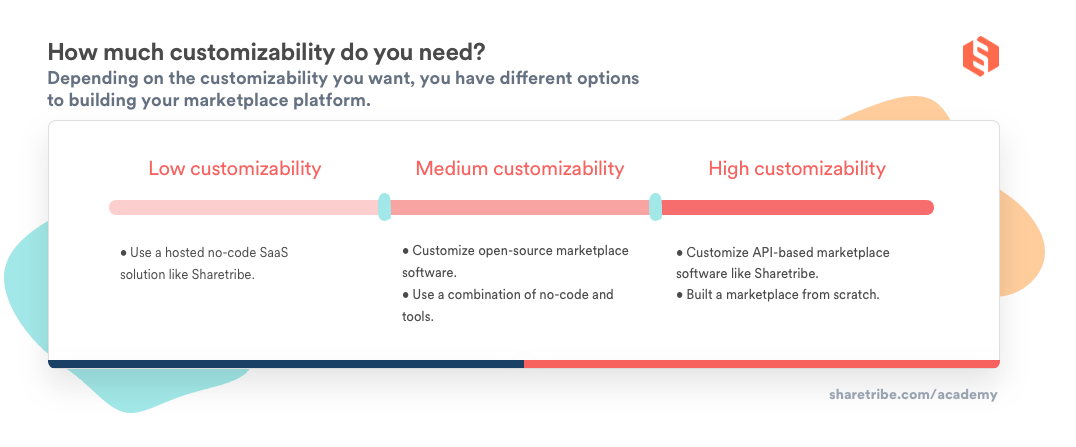Six ways to develop a marketplace website
Find the best way to build your online marketplace platform – the actual website with the necessary marketplace features and functionality. Compare and choose the right approach for your idea, budget, technical skills, and timeline.
Successful online marketplace platforms are about much more than marketplace technology. In fact, when you’re planning to develop a marketplace, we recommend focusing more on the business side rather than your platform itself.
However, building the actual marketplace website will be on the agenda sooner or later. That means you’ll need an actual marketplace platform with the necessary two-sided features and functionality that allows your site to work for your business idea.
Many think they need to code a platform to create a marketplace. This is almost never the case.
Many early-stage marketplace entrepreneurs think you need to code your own marketplace platform to get the features that they need.
But this is almost never the case.
There are many alternatives to developing a marketplace website from scratch. Most of them will save you time, money, or both. And even better, there are many solutions that don’t require any development skills. In fact, it has never been easier to create an online platform.
With so many alternative approaches to take, how you build your platform is one of the most important decisions you make. It will determine your launch time, your feature set, your workload (and the skills you need to overcome it), and your required budget. As you’ll find out reading this article, the scale for each of these variables is huge. You’ll likely need to make some trade-offs depending on which of them is your biggest constraint.
This article will also help you make the right trade-offs and ensure you get the most out of your time, money, and skills.
There are six ways to build an online marketplace platform:
- Code it from scratch (or pay someone to do it)
- Build on top of open-source marketplace software (self-hosted)
- Build it using a generic website or e-commerce builder and marketplace plugins, themes, or extensions
- Build it yourself by combining several no-code tools
- Build it yourself using a dedicated no-code marketplace software solution (SaaS)
- Develop on top of an API-based marketplace solution
Each of these approaches has its pros and cons. In order to compare them, we look at four factors:
- Time to market
- Tech skills needed
- Price
- Customizability.
How important each factor is depends on your situation. But judging all methods against the same background helps you make the right decision for your situation.
Now, let’s compare.
Chapter 2
Description: Developing your online marketplace platform from scratch, either on your own or by hiring a developer or an IT-company.
Biggest benefit: You can make it work and look exactly as you wish.
Biggest drawback: Takes a lot of time and expertise or a budget north of $50,000.
This approach lets you build exactly the kind of platform you have in mind. If you are an accomplished developer, the do-it-yourself option is often tempting. There are a number of other benefits, too: you have access to all the source code, you’re not dependent on third-party software, there are no licensing issues and no subscription costs.
If you have the budget for it, you can pay a developer to build a platform for you. With someone else taking care of the technical work, you can focus your attention on the business side of the marketplace, which is no small benefit.
As tempting as this option may sound, there are considerable drawbacks. First of all, building a multi-sided platform with a flawless transaction flow from scratch will take time—a lot of it. The surest way to success, however, would be to launch your marketplace as fast as possible.
Another downside is that learning and iterating takes a long time. You might end up spending dozens of hours developing a feature only to notice it isn’t very useful or interesting to your users.
Existing software tools leave you time develop custom marketplace features that delight your users.
You also need to maintain your site on your own, which is a lot of work. Technology, user experience trends, and even online payment regulation evolve quickly. Existing software tools would take care of maintenance work and updates for you, leaving you time to grow your business and develop custom features that will genuinely delight your users.
You can reduce some building time by hiring an IT-company to do the work for you. Even then, it likely takes at least three months to get your site launched. Simply finding a marketplace developer that you are comfortable working with and who deliver high-quality software can be a challenge and easily take a lot of time.
Furthermore, though prices for development vary a lot, even the most cost-efficient choice might set you back north of $50,000 to launch your site. You will also need to continue development work to improve your platform based on feedback, pay monthly hosting bills, and update and maintain your platform.
Chapter 3
Description: Using a marketplace software solution that can be downloaded as open-source (or for a one-time fee), modified, and hosted on your own server.
Biggest benefit: Cheaper and faster than building from scratch.
Biggest drawback: Requires development work to build and maintain, and the developer experience can be less than ideal.
This option is faster than building your marketplace platform from scratch. Every marketplace has some basic functionality requirements, such as creating a listing, communication between users, and handling bookings and transactions. Existing marketplace software will already have most, if not all, included.
You can also develop additional features on top of the existing feature set, or at the very least, customize the look and feel of the marketplace.
Even though the software is open-source, hosting, updates, and maintenance incur monthly costs.
If you can pay for multiple developers to do the work, the platform will be ready to launch a lot sooner than if you would be doing it yourself. In any case, it will likely be a lot less expensive than outsourcing the development of the marketplace from scratch.
Just as with building a platform from scratch, the time to launch—and for the learning to start—is still a factor to consider. The software used and your development budget will play a role, but 1—3 months is a realistic estimate.
In any case, finding the best open-source software that is as fast and easy as possible to customize is a challenge. The developer experience on open-source software products may vary a great deal, and some customizations may require lots of frustrating manual tasks and less than ideal workarounds. An API-based marketplace software that is designed to be customized and expanded very likely offers a quicker and smoother developer experience.
Even though the software is open-source, hosting incurs monthly costs. Depending on which open-source software you choose, the work needed to maintain and update it might also be significant. For example, if the software creator doesn’t offer updates in cases of changes in legal requirements related to marketplace payments, for example, you might be in for weeks of work. When your marketplace reaches a large scale, dev-ops work will likely become a full-time job.
Chapter 4
Description: Using a generic website builder and adding the essential marketplace functionality by installing various marketplace plugins, themes, or extensions.
Biggest benefit: Website builder features with a low monthly cost.
Biggest drawback: Vulnerability and UX challenges due to an interplay of multiple plugins.
When you’re looking at generic website or e-commerce builders, there are lots of affordable and beautiful solutions to choose from. Wordpress, Squarespace, and Wix are examples of website builders, and Shopify and Magento are perhaps the best-known no-code or low-code e-commerce tools.
Some of these website builders also allow for customizations with the help of different kinds of extensions. For instance, there are marketplace plugins available that allow for adding a multi-vendor functionality to a regular online e-commerce store. If you know one of these tools and its plugins like the back of your hand, using a more generic website builder might be the cheapest route to market.
Even if generic website builders might be an affordable way to launch a marketplace, they very likely won’t be the fastest. Taking this approach means you need to design your marketplace user experience (for both customers and providers) and then find the right plugins, install them, and test and optimize every stage in the user journey. To provide the seamless, lovable experience today’s users expect, this step might consume several weeks.
Chapter 5
Description: Building a marketplace platform using a combination of several no-code tools.
Biggest benefit: More customizability than a no-code marketplace SaaS tool in terms of layout and functionality.
Biggest drawback: Longer time to launch and a much steeper learning curve of the different tools.
If you are already familiar with a set of no-code tools, this could be a great method to create your marketplace. You can create exactly the functionality and layout you want to the extent that the tools permit. It also keeps the door open for future improvement and feature additions. Finally, if you are a “maker”, you probably also get a lot of satisfaction out of using familiar no-code tools to build something new.
First, you will need to figure out which tools you need to build the marketplace you want. This requires a good understanding of all essential marketplace functionality and a rough idea how to build that with the tools.
Learning to use all the necessary no-code tools can take several weeks.
A common no-code tool set is: Webflow as the CMS/frontend of your marketplace, Airtable as the database, Zapier for the different workflows/automation, and Memberstack to create the user management part & gated content. In addition, you might need Parabola to sync the data in the different tools together and Jetboost to create dynamic filters and real-time search for Webflow.
If you don’t know these tools, you will first need to learn each of them. This can take several weeks, if not months. Once you are proficient, the actual building will also likely set you back several weeks. Even for very experienced no-code tool users, building a fully featured marketplace can still take anywhere between two weeks and several months.
Today's users expect a seamless, lovable user experience.
Building with a marketplace SaaS tool (sometimes also called marketplace-as-a-service, or MaaS) is the fastest way to launch an online marketplace platform. Some of Sharetribe's customers have launched their marketplace in just one day.
Launching fast lets you validate how your business idea works in reality and which features are important for your users.
More importantly, relying your core functionality on an interplay of individual plugins might make your site more vulnerable. If one of your plugins fails, your entire revenue stream might clog. Updating or replacing plugins might also create conflicts with other plugins supporting your infrastructure, resulting in lots of maintenance work.
Especially as your marketplace grows and you want to extend your feature set and improve your UX, the sheer amount of plugins might make maintaining your marketplace a full-time job.
A marketplace SaaS tool is the fastest way to launch an online marketplace platform.
Secondly, this method likely gets you the best marketplace UX with the lowest investment. Only using a generic website builder with plugins might be a slightly cheaper option if you don't calculate the time spent building and maintaining your architecture and if you're willing to compromise on the user experience.
Additionally, SaaS software is usually battle-tested. A marketplace business's biggest value-add is convenience, and the companies that have years of marketplace expertise usually know how to deliver it. In most cases, marketplace SaaS companies continuously test, improve, and update their product. This ensures your platform is always up to date with evolving user requirements and that you have powerful tools to run your business.
A final benefit is the required technical knowledge. Although the needed level depends on the exact marketplace software, in most cases, basic internet savviness is enough. You will rarely need to read or write code but still get to be in full control over your own business.
Marketplace software providers attempt to serve as many customers and cases as possible, so they will have certain limitations. You might not be able to launch with all the features that you had in mind.
Another concern for a no-code tool is its scalability. While the tools themselves might be able to handle hundreds of thousands of users, at some point, you'll probably want to expand your platform and feature set to serve your audience even better. Especially if you have big ambitions about where you want your business to go, it's a good idea to choose an MVP solution that offers you a clear path to grow your business and your platform.
Sharetribe's software is built with this path in mind. Unlike other no-code marketplace builders, with Sharetribe, you can launch your MVP completely no-code. You can grow your user base and learn about your audience with minimal upfront investment. Once you're ready to build custom functionality and make your marketplace unique, you can do so on top of Sharetribe's software without changing platforms or migrating data. Learn more about building a custom-developed marketplace with Sharetribe in the next chapter.
Chapter 7
Description: Creating a unique marketplace on top of the essential features offered by an API-based marketplace SaaS tool.
Biggest benefit: Best of both worlds: the customizability of coding from scratch and the fast time to market of a no-code SaaS tool.
Biggest drawback: Requires more technical skills (or a developer partner or outsourcing development), time, and money than a no-code tool.
The biggest benefit of API-based marketplace software is that it gives you full freedom to develop your unique marketplace features without needing to pay attention to the marketplace essentials.
This saves considerable time and work, and you can be sure that critical marketplace and payment features work like a charm. For example, our developer partners from around the world have estimated that building a custom marketplace with Sharetribe is about 90–95% cheaper and faster than building a marketplace from scratch.
An API-based marketplace software can be 90–95% cheaper and faster than building from scratch.
In terms of customizability, an API-based solution is a lot more flexible than even the most advanced no-code tools. You can freely design your ideal front-end and user experience, build custom features and payment flows, and integrate third-party software like email marketing tools or CRMs.
A third big benefit is that an API-based solution is typically extremely future-proof. If the software provider handles maintenance, backups, security, and compliance, you won’t have to hire a full-time dev-ops person to make sure your marketplace runs as it should. At the same time, you have full freedom to develop the platform as your business and user base evolves. The software provider will also continue to update and improve the product, so you’ll benefit from their research and development efforts as well.
Using an API-based marketplace software tool will always require development skills, so if you’re not a developer, you need to hire someone to help you. Depending on the type and extent of customizations and the architecture of the software you’ve chosen, the needed skills may vary a lot.
Developing on top of APIs is quicker and more affordable than building from scratch but slower and more expensive than using a no-code tool. That's why Sharetribe combines these two approaches. You can launch and run your marketplace completely no code and develop custom functionality at the same time. Once you're ready to launch your unique functionality, you only need to move from a hosted Sharetribe marketplace to self-hosting your front-end solution. Sharetribe continues to take care of all maintenance, backups, and backend software updates.
The software provider’s documentation, API reference, templates, and developer tooling can have a big impact on how quickly you can get your marketplace live. If you choose an API-based marketplace software, comparing providers based on developer experience is a good idea.
Start with a fast no-code tool and move to an API-based solution after your idea is validated.
If you need to hire a developer, it will require some initial investment. The cost may vary greatly depending on where you buy the development work. Sharetribe has vetted developer and designer partners, who provide custom development services for our customers. The budget needed for custom development depends on your requirements. If you want to add just one feature, the necessary budget can be very small.
According to our Experts, the typical cost of a full customization project, with new design and features, is around $5k–$10k.
Usually, API-based marketplace tools are more powerful than no-code tools, which also makes them more expensive. If your budget is limited, starting with a no-code solution (like a hosted Sharetribe marketplace) first is a recommended approach, even if you have more developer skills or a large budget. More advanced software is a good next step after you have validated your business idea with a faster and less expensive tool.
We cannot emphasize enough the importance of launching your Minimum Viable Platform as quickly as possible.
The most important resource an early-stage marketplace entrepreneur has is their time. It’s critical to use as much of it as possible on activities that help validate and grow the business. For this reason, using a marketplace SaaS tool is almost always the best method to start with. It is the fastest way to start learning and iterating on your marketplace idea and your business model.
The most important resource an early-stage marketplace entrepreneur has is their time.
But if we leave this assumption aside for a moment, the right method for you depends heavily on your answer to these three questions:
- How big is your budget?
- What are your technical skills?
- How quickly do you want to launch your marketplace?
- How much flexibility/customizability do you need?
With this budget, paying someone else to build a marketplace platform from scratch is pretty much out of the question. Your best option is to start using a SaaS solution, open-source marketplace software, or generic website or e-commerce builders. If you’re technical, coding the platform is also possible. You could also use Sharetribe self-hosted, and only pay a developer to add one or two unique features with a small budget.
Paying someone to code from scratch is still off the table, but for most API-based marketplace software, this budget will be perfect for building a unique marketplace and even saving something for additional features or updates based on feedback from your early customers.
Another option that is available to you is using an open-source marketplace software or a generic website builder and paying someone to develop a marketplace on top of it. However, the budget might not leave much room for additional features or updates after you’ve launched your marketplace. This will depend a lot on the software you choose and the hourly rate of your developer.
If you are technical, this is a perfect budget for building the platform yourself on top of either API-based SaaS or open-source marketplace software. You can use the money you save on development costs for much-needed things such as marketing and promotion.
With a budget of this size, you should be able to find companies that can build a high-quality custom marketplace, either from scratch or based on existing software. Various options exist. The right choice depends mostly on the type of marketplace needed, your exact customization requests, and how quickly you would like to launch.

Coding from scratch is obviously not an option unless you first want to invest a year or so learning how to code. Your best choice is to either launch using a SaaS solution that is aimed at less technical users or hire someone to build the platform for you.
You might, at one point, have used a WordPress blog and edited some HTML or CSS. With this technical proficiency, most no-code marketplace SaaS platforms are a perfect fit. You also have enough skills to put together a functional marketplace with WordPress marketplace plugins or Magento extensions, for example.
If you feel like expanding your coding skills, you could check out the development skills required to work with a self-hosted Sharetribe marketplace and see how far you get. You’d likely also be able to take care of basic UX modifications for an open-source marketplace software. Depending on the software and your needs, this might very well be enough for launching your MVP.
As a developer, building the platform from scratch is always an option. However, using one of the many existing marketplace software packages out there—both open-source and proprietary—will give you a head start, letting you focus on developing the features that are specific to your marketplace. If you have a bit of a budget, choosing a software solution with APIs gets you to market the fastest and probably offers the best developer experience.

Having only a month seriously limits the amount of work you can do. The only real option is to use a SaaS solution that has all of the essentials (hosting, transactions, reviews, etc.) and only needs visual customizations. Even the most expensive developers/agencies will unlikely be able to deliver a fully functional marketplace platform in less than a month.
A SaaS solution is still a great option, as is customizing existing marketplace software, either by yourself or using a third party. Three months should also give you enough time to set up hosting, a development environment, and modify the code to your needs. If you prefer to use a generic website or e-commerce builder, three months is plenty of time to compare and set up the extensions and plugins.
With this schedule, all options are on the table. What you end up choosing will be mostly determined by your budget and your technical skills.

Some marketplace ideas might, at first, seem like they need extensive customizability. If that is the case, this restriction will very likely exclude all no-code or low-code tools and most Saas tools. An API-based Saas or coding from scratch are your alternatives, both of which require either development skills or some budget (building from scratch significantly more).
The biggest drawback of these approaches is that they take a lot more time than a no-code marketplace builder to launch. In our experience, most early-stage marketplace entrepreneurs would be much better off choosing a fast launch time and low costs over customizability to launch their MVP.
If you have a sufficient budget (or time and development skills), an open-source Saas solution or a combination of no-code tools might be a good alternative for you. This gives you some freedom over your feature set and a bit more over the look and feel without having to build everything from scratch.
Depending on your skill set, this alternative might still set you back several months.
A hosted version of a no-code Saas tool offers the lowest customizability. You’re typically able to adjust the look and feel to fit your brand and make choices between the exact features you’ll take into use. Building new features isn’t possible.
At the same time, a no-code Saas tool far exceeds all the other options in ease of use and extremely fast launch time.
In most cases, this is a sensible trade-off to make. Launching fast allows an early-stage entrepreneur to start validating the idea fast, find product-market fit, and learn what users truly need. When it’s time for version 2.0 of their platform, you have hard evidence to help you prioritize the most important features. Depending on the method chosen, this experience can mean months and several thousands of dollars shaved off the build budget.

In conclusion
We have now described the different methods of building a marketplace and the benefits and drawbacks of these methods. We’ve also discussed other factors that might affect your decision: your budget, technical skills, how much time you’re willing to spend on the development phase, and how much customizability you need. The underlying recommendation behind our discussion is to find the solution that gets your idea out into the world the quickest.
This information should give you a good idea of what approach best fits your situation.
If you’re leaning towards using a Saas tool, this article might help you with comparing marketplace software providers. This article about deciding your first year’s budget might also be helpful.
Start your 14-day free trial
Create a marketplace today!
- Launch quickly, without coding
- Extend infinitely
- Scale to any size
No credit card required
